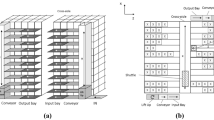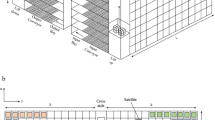Abstract
The increased need for just-in-time delivery of finite goods has pulled the development of novel automation solutions to manage warehouse activities. Among the available technologies, autonomous vehicle storage and retrieval systems (AVS/RS) rely on light vehicles able to travel independently and to perform different tasks at the same time, thus exhibiting enhanced flexibility and increased throughput level. Nonetheless, techniques to evaluate the performance of such systems still exhibit some gaps and are mainly focused on simple configurations. This paper aims to extend the state of the art by introducing novel analytical models capable to assess the performance of a tier-to-tier, multi-shuttle AVS/RS feeding a deep-lane rack. The proposed approach enables to evaluate the expected cycle time and throughput by (i) enabling the possibility to consider the real criteria adopted to store and retrieve items, and (ii) taking into account the ability of the vehicles to simultaneously perform different tasks. The model is validated against simulations performed on different rack layouts, on AVS/RS with different fleet compositions, for different types of cycle. The developed model aims to support both the design and the deployment phases of AVS/RS by enabling quick and accurate performance estimation in a wide variety of scenarios.




Similar content being viewed by others
References
Markets and Markets (2017) Automated storage and retrieval system (ASRS) market by type (unit load, mini load, VLM, carousel, autostore, & mid load), function (assembly, storage, order picking, kitting, & distribution), industry, and geography - global forecast to 2023. Available at https://www.marketsandmarkets.com/Market-Reports/automated-storage-retrieval-system-market-195267987.html
Malmborg CJ (2002) Conceptualizing tools for autonomous vehicle storage and retrieval systems. Int J Prod Res 40(8):1807–1822. https://doi.org/10.1080/00207540110118668
Tappia E, Marchet G, Melacini M, Perotti S (2015) Incorporating the environmental dimension in the assessment of automated warehouses. Prod Plan Control 26(10):824–838. https://doi.org/10.1080/09537287.2014.990945
FEM European materials handling federation (2017) Standard 9.860. Cycle time calculation for automated vehicle storage and retrieval systems
Malmborg CJ (2003) Interleaving dynamics in autonomous vehicle storage and retrieval systems. Int J Prod Res 41(5):1057–1069. https://doi.org/10.1080/0020754021000033887
Kuo PH, Krishnamurthy A, Malmborg CJ (2007) Design models for unit load storage and retrieval systems using autonomous vehicle technology and resource conserving storage and dwell point policies. Appl Math Model 31:2332–2346. https://doi.org/10.1016/j.apm.2006.09.011
Fukunari M, Malmborg CJ (2008) An efficient cycle time model for autonomous vehicle storage and retrieval systems. Int J Prod Res 46(12):3167–3184. https://doi.org/10.1080/00207540601118454
Fukunari M, Malmborg CJ (2009) A network queuing approach for evaluation of performance measures in autonomous vehicle storage and retrieval systems. Eur J Oper Res 193(1):152–167. https://doi.org/10.1016/j.ejor.2007.10.049
Zhang L, Krishnamurthy A, Malmborg CJ, Heragu SS (2009) Variance-based approximations of transaction waiting times in autonomous vehicle storage and retrieval systems. Eur J Ind Eng 3(2):146–169. https://doi.org/10.1504/EJIE.2009.023603
Roy D, Krishnamurthy A, Heragu SS, Malmborg CJ (2012) Performance analysis and design trade-offs in warehouses with autonomous vehicle technology. IIE Trans 44(12):1045–1060. https://doi.org/10.1080/0740817X.2012.665201
Roy D, Krishnamurthy A, Heragu SS, Malmborg CJ (2015) Stochastic models for unit-load operations in warehouse systems with autonomous vehicles. Ann Oper Res 231(1):129–155. https://doi.org/10.1007/s10479-014-1665-8
Roy D, Krishnamurthy A, Heragu SS, Malmborg CJ (2017) A multi-tier linking approach to analyze performance of autonomous vehicle-based storage and retrieval systems. Comput Oper Res 83:173–188. https://doi.org/10.1016/j.cor.2017.02.012
Epp M, Wiedemann S, Furmans K (2017) A discrete-time queueing network approach to performance evaluation of autonomous vehicle storage and retrieval systems. Int J Prod Res 55(4):960–978. https://doi.org/10.1080/00207543.2016.1208371
Ekren BY, Heragu SS (2009) Simulation based regression analysis for rack configuration of autonomous vehicle storage and retrieval system. The 2009 Winter Simulation Conference
Ekren BY (2011) Performance evaluation of AVS/RS under various design scenarios: a case study. Int J Adv Manuf Tech 55(9):1253–1261. https://doi.org/10.1007/s00170-010-3137-x
Marchet G, Melacini M, Perotti S, Tappia E (2012) Analytical model to estimate performances of autonomous vehicle storage and retrieval systems for product totes. Int J Prod Res 50 (24):7134–7148. https://doi.org/10.1080/00207543.2011.639815
Carlo HJ, Vis IFA (2012) Sequencing dynamic storage systems with multiple lifts and shuttles. Int J Prod Econ 140:844–853. https://doi.org/10.1016/j.ijpe.2012.06.035
Lerher T, Ekren BY, Dukic G, Rosi B (2015) Travel time model for shuttle-based storage and retrieval systems. Int J of Adv Manuf Tech 78(9):1705–1725. https://doi.org/10.1007/s00170-014-6726-2
Lerher T (2016) Travel time model for double-deep shuttle-based storage and retrieval systems. Int J Prod Res 54(9):2519–2540. https://doi.org/10.1080/00207543.2015.1061717
Lerher T (2018) Aisle changing shuttle carriers in autonomous vehicle storage and retrieval systems. Int J Prod Res 56(11):3859–3879. https://doi.org/10.1080/00207543.2018.1467060
Ekren BY, Akpunar A, Sari Z, Lerher T (2018) A tool for time, variance and energy related performance estimations in a shuttle-based storage and retrieval system. Appl Math Model 63:109–127. https://doi.org/10.1016/j.apm.2018.06.037
Borovinsek M, Ekren BY, Burinskiene A, Lerher T (2017) Multi-objective optimisation model of shuttle-based storage and retrieval system. Transport 32(2):120–137. https://doi.org/10.3846/16484142.2016.1186732
Ning Z, Lei L, Saipeng Z, Lodewijks G (2016) An efficient simulation model for rack design in multi-elevator shuttle-based storage and retrieval system. Simul Modell Pract Theory 67:100–116. https://doi.org/10.1016/j.simpat.2016.03.007
Lerher T, Ekren BY, Sari Z, Rosi B (2015) Simulation analysis of shuttle based storage and retrieval systems. Int J Simul Modell 14(1):48–59. https://doi.org/10.2507/IJSIMM14(1)5.281
Lerher T, Borovinsek M, Ficko M, Palcic I (2017) Parametric study of throughput performance in SBS/RS based on simulation. Int J Simul Model 16(1):96–107. https://doi.org/10.2507/IJSIMM16(1)8.372
Ekren BY (2017) Graph-based solution for performance evaluation of Shuttle-Based Storage and Retrieval System. Int J Prod Res 55(21):6516–6526. https://doi.org/10.1080/00207543.2016.1203076
Ha Y, Chae J (2019) A decision model to determine the number of shuttles in a tier-to-tier SBS/RS. Int J Prod Res 57(4):963–984. https://doi.org/10.1080/00207543.2018.1476787
Tappia E, Roy D, De Koster R, Melacini M (2017) Modeling, analysis, and design insights for Shuttle-Based Compact Storage Systems. Transport Sci 51(1):269–295. https://doi.org/10.1287/trsc.2016.0699
Manzini R, Accorsi R, Baruffaldi G, Cennerazzo T, Gamberi M (2016) Travel time models for deep-lane unit-load autonomous vehicle storage and retrieval system (AVS/RS). Int J Prod Res 54(14):4286–4304. https://doi.org/10.1080/00207543.2016.1144241
Ekren BY, Heragu SS, Krishnamurthy A, Malmborg CJ (2010) Simulation based experimental design to identify factors affecting performance of AVS/RS. Comput Ind Eng 58:175–185. https://doi.org/10.1016/j.cie.2009.10.004
D’Antonio G, De Maddis M, Sauza Bedolla J, Chiabert P, Lombardi F (2018) Analytical models for the evaluation of deep-lane autonomous vehicle storage and retrieval system performance. Int J of Adv Manuf Tech 94(5-8):1811–1824. https://doi.org/10.1007/s00170-017-0313-2
Bozer YA, White JA (1984) Travel-time models for automated storage/retrieval systems. IIE Trans 16 (4):329–338. https://doi.org/10.1080/07408178408975252
Bruno G, D’Antonio G (2018) Flexible reconfiguration of AVS/RS operations for improved integration with manufacturing processes. Procedia CIRP 78:196–201. https://doi.org/10.1016/j.procir.2018.09.052
Author information
Authors and Affiliations
Corresponding author
Additional information
Publisher’s note
Springer Nature remains neutral with regard to jurisdictional claims in published maps and institutional affiliations.
Appendix A: Description of the simulation model
Appendix A: Description of the simulation model
This section contains a high-level description of the simulation model used for validation of the developed approach.
1.1 A.1 Initialization model
A first model has been developed to generate 10 datasets to be used in the different repetitions of each configuration to be simulated: such datasets contain the rack content to be loaded at the beginning of the simulation and a list of ULs to be stored and retrieved.define rackCapacity = N_x⋆N_y⋆N_zfor i = 1:numberOfRepetitions
generate the empty rack structure
set storageCriterion: Closest
Channel
set retrievalCriterion: Random
for j = 1:rackCapacity
generate the jth UL
provide the jth UL with a
random UL type
define the jth UL position in
the rack
accordingly to the
storageCriterion
update rack content
end
for j = 1:fillRate⋆rackCapacity
require retrieval of a UL with
a random type
select the UL to be retrieved
accordingly to
the retrievalCriterion
make the rack position free and
update rack content
end
for j = 1:numberOfInvolvedULs
generate a new UL to be stored
generate a new UL to be
retrieved
provide the two ULs with a
random UL type
end save ith rack content
save ith list of storage and
retrieval ULs end
1.2 A.2 Simulation model
Here, the model that simulates UL storage and retrieval is presented: the results of the former model are used here as an input; the output mainly consists in the evaluation of the average cycle time and an array (which size is equal to rack capacity) listing the number of storage/retrieval activities occurred in each rack position: this is the basis to evaluate the probability distributions a, b, c.load rack configuration and initial contentload the list of storage and retrieval ULsload simulation configuration: storageCriterion,
retrievalCriterion, N_S, L, S, P, U define numberOfCycles = 20000/U define arrayOfInteractions = zeros(size: rackCapacity) for i = 1:numberOfCycles
identify the U items in the list
involved in
the actual cycle
decide the rack positions of ULs to
be stored
accordingly to the
storageCriterion
decide the rack positions of ULs to
be retrieved
accordingly to the
retrievalCriterion
start timeCounter
run vehicles movements to
store/retrieve the U
items, accordingly to cycle
specifications and
to the defined rack positions
end timeCounter
set cycleDuration(i) = timeCounter
increase by one unit the
appropriate value of
arrayOfInteractions end evaluate a, b, c based on arrayOfInteractions evaluate avgCicleDurationSimulation = mean(...
cycleDuration(1:numberofCycles)
Rights and permissions
About this article
Cite this article
D’Antonio, G., Chiabert, P. Analytical models for cycle time and throughput evaluation of multi-shuttle deep-lane AVS/RS. Int J Adv Manuf Technol 104, 1919–1936 (2019). https://doi.org/10.1007/s00170-019-03985-8
Received:
Accepted:
Published:
Issue Date:
DOI: https://doi.org/10.1007/s00170-019-03985-8




